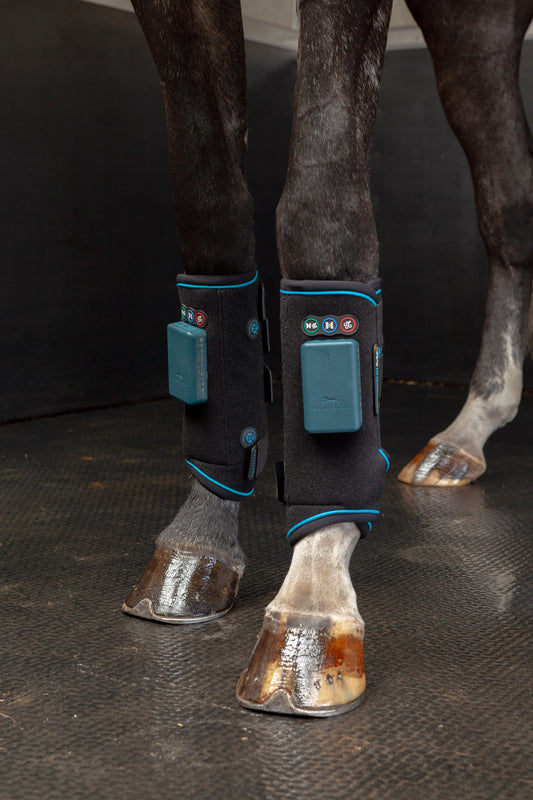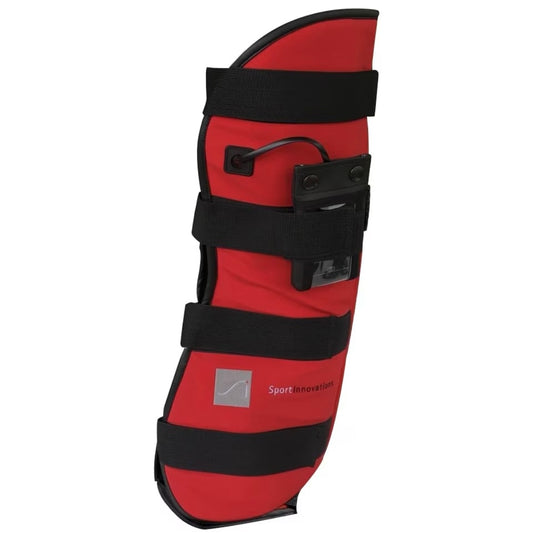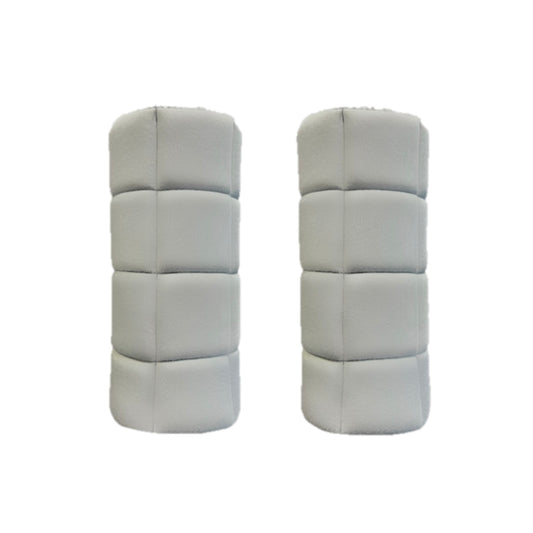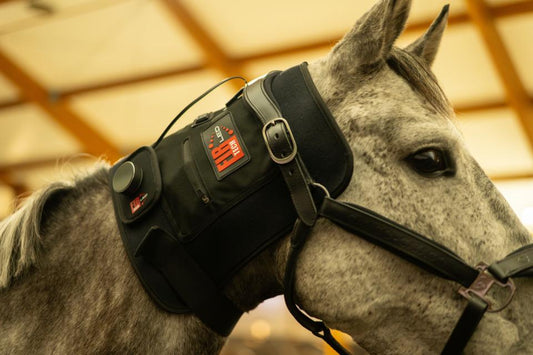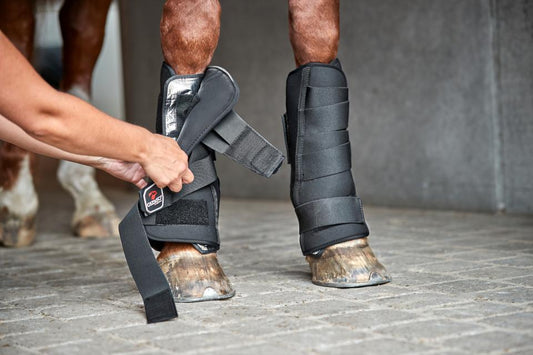Bone Injuries
Fractures
A fracture in horses refers to a break in the bone, which can range from a simple crack to a complete break with displacement. Fractures can occur anywhere in the skeleton, though they most commonly affect the limbs. A fracture can be caused by trauma or degenerative changes in the bone. Prompt diagnosis and proper management are critical to ensure a successful recovery and minimize the risk of long-term complications.
General Information
Fractures in horses can be classified into different types based on the location and severity of the injury:
- Simple Fractures: The bone is broken, but the fracture does not pierce the skin. These are typically easier to treat and manage.
- Compound Fractures: These involve a break in the bone where it pierces through the skin, creating an open wound. They are more serious due to the risk of infection.
- Comminuted Fractures: The bone is broken into several pieces, often requiring surgical intervention for proper alignment and healing.
- Stress Fractures: These are microfractures that develop over time due to repetitive stress on the bone, common in performance horses that engage in high-impact activities.
- Greenstick Fractures: A type of fracture that does not break all the way through the bone, common in younger horses whose bones are still developing.
The type of fracture and the location on the bone determine the treatment approach and healing process.
How to Recognize a Fracture
Signs of a fracture in a horse can vary depending on the injury's type, location, and severity. Common symptoms include:
- Severe Lameness: The horse may refuse to bear weight on the affected limb and may not be able to stand in severe cases.
- Swelling and Heat: The injured area may be swollen and warm due to inflammation.
- Visible Deformity: In displaced or compound fractures, the bone may be visibly misaligned or protruding through the skin.
- Pain on Palpation: Gently applying pressure to the injury site may cause the horse to react with pain.
- Bruising: Bruising around the fracture site may appear due to internal bleeding.
- Restricted Movement: The horse may avoid moving the affected limb or show abnormal gait.
- Shock Symptoms: In severe cases, the horse may exhibit signs of shock such as rapid breathing, increased heart rate, and sweating.
Causes of Fractures
Fractures in horses can occur due to various reasons, including:
- Trauma: Accidents such as falls, kicks from other horses, collisions, or being struck by heavy objects are common causes.
- Overuse or Stress: High-performance activities like racing, eventing, and jumping can lead to stress fractures over time.
- Poor Conformation: Horses with misaligned legs or hooves may develop stress fractures due to abnormal forces on the skeletal system.
- Weak or Fragile Bones: Older horses or those with metabolic disorders, like Cushing's disease or osteoporosis, may have weaker bones that are more prone to fractures.
- Inadequate Nutrition: Nutritional deficiencies, particularly a lack of calcium, phosphorus, or vitamin D, can weaken bones and increase fracture risk.
How to Prevent Fractures
While not all fractures can be prevented, the following practices can reduce the risk:
- Proper Training and Conditioning: Gradually increasing exercise intensity strengthens bones and muscles, reducing the risk of overuse injuries.
- Correct Conformation: Ensuring good conformation and regular farrier care helps reduce stress on limbs and joints.
- Safe Environment: Maintain a safe environment by avoiding slippery or uneven surfaces to reduce traumatic falls.
- Preventing Overexertion: Monitor for signs of fatigue or discomfort, and avoid pushing the horse too hard without adequate rest.
- Bone Health: Provide a balanced diet with adequate calcium, phosphorus, magnesium, and vitamins like Vitamin D to support strong bones.
- Regular Veterinary Checks: Routine veterinary exams help detect early signs of bone degeneration or conditions that may predispose the horse to fractures.
What to Do if Your Horse Has a Fracture
If you suspect your horse has a fracture, follow these steps:
- Immediate Assessment: Stay calm and keep the horse still to prevent further damage to the bone and tissues.
- Call a Veterinarian: Contact your veterinarian immediately. Diagnostic imaging (X-rays or ultrasound) will be needed to determine the injury's extent.
- Control Bleeding: If the fracture is open and bleeding, apply a sterile bandage or clean cloth to control bleeding until the vet arrives.
- Pain Relief and Anti-Inflammatories: Your vet may administer NSAIDs (e.g., phenylbutazone) to relieve pain and reduce inflammation.
- Rest and Support: Box rest or stall confinement may be recommended to prevent movement of the injured limb. In some cases, a cast or external fixator may be used to stabilize the fracture.
- Surgical Intervention: For displaced or comminuted fractures, surgery may be necessary to realign the bone and secure it with pins, plates, or screws.
- Post-Surgical Care: After surgery, your horse will need prolonged rest and gradual rehabilitation under the guidance of the veterinarian.
Therapies to Aid in Recovery
Several therapies can support the healing process and alleviate discomfort:
- PEMF Therapy (Pulsed Electromagnetic Field Therapy): Stimulates bone regeneration, reduces inflammation, and promotes cellular healing, which accelerates bone healing.
- Cold Therapy: Ice packs or cold compresses help reduce swelling and manage inflammation, especially in the early stages of healing.
- Laser Therapy: Infrared laser therapy improves blood circulation and promotes tissue healing, particularly beneficial during the recovery phase.
- NMES (Neuromuscular Electrical Stimulation): Stimulates muscles around the fracture site to prevent muscle atrophy and enhance circulation, supporting tissue repair.
- Nutritional Support: Joint and bone supplements, including calcium, magnesium, and vitamin D, support bone healing and reduce recovery complications.
Conclusion
Fractures in horses are serious and painful injuries, but with prompt intervention, proper management, and the use of advanced therapies, horses can recover and return to their normal activities. Early diagnosis, rest, and therapies like PEMF, cold therapy, and laser therapy play a vital role in the recovery process. Always consult with your veterinarian to ensure the best possible outcome for your horse.
Bone Bruises
A bone bruise, or bone contusion, occurs when the bone experiences trauma, leading to localized damage without a fracture. It involves the soft tissue inside the bone, particularly the trabecular bone and bone marrow, and is often accompanied by inflammation. Bone bruises are common in performance horses and are typically caused by blunt force trauma or repetitive impact. While not as severe as fractures, bone bruises can still cause significant pain and discomfort and require proper treatment for recovery.
How to Recognize a Bone Bruise
Recognizing a bone bruise can be difficult, as its symptoms can resemble other musculoskeletal injuries. However, common signs include:
- Lameness: Sudden, localized lameness, especially after injury or excessive stress. The severity can vary.
- Swelling: Swelling over the injured bone due to inflammation. It may not be as pronounced as fractures but is noticeable.
- Pain on Palpation: When pressure is applied, the horse may react with pain, often by pulling the leg away.
- Heat: The affected area may feel warm due to inflammation.
- Stiffness: The horse may show signs of stiffness, particularly when moving or exercising.
- History of Trauma: Bone bruises often occur after an event involving blunt force, like a fall, kick, or impact.
Causes of Bone Bruises
Bone bruises in horses are typically caused by trauma or repetitive pressure:
- Trauma: Direct impacts, such as falls, kicks, or collisions, are common causes of bone bruises.
- Overuse: Repetitive strain or impact, common in competitive disciplines like racing and eventing, can lead to micro-trauma and bruising.
- Hard Surfaces: Training on hard or uneven surfaces can contribute to bone bruising due to excessive force on the bones.
- Conformation Issues: Horses with poor conformation, such as misaligned limbs or abnormal gaits, may be more prone to bone bruises.
- Inadequate Foot Care: Improper hoof trimming can cause abnormal weight distribution, increasing stress on certain areas.
- Lack of Conditioning: Horses not properly conditioned for specific activities may experience more direct impact on their bones, leading to bruising.
How to Prevent Bone Bruises
While not all bone bruises can be prevented, the following measures can help reduce the risk:
- Gradual Conditioning: Gradually increase exercise intensity to allow the bones, muscles, and joints to adapt.
- Rest and Recovery: Provide sufficient rest between intense sessions to reduce cumulative stress on the bones.
- Protective Equipment: In certain disciplines, use protective leg wraps or boots to shield bones and soft tissues from impacts.
- Proper Foot Care: Regular hoof trimming and shoeing are essential to ensure proper weight distribution and prevent bruising.
- Surface Considerations: Work on forgiving, well-maintained surfaces to reduce repetitive impact.
- Adequate Nutrition: Ensure your horse has a balanced diet with sufficient calcium, phosphorus, and vitamin D for bone health.
What to Do if Your Horse Has a Bone Bruise
If you suspect your horse has a bone bruise, follow these steps:
- Immediate Assessment: Confine the horse to prevent further injury and limit movement to avoid worsening the damage.
- Veterinary Consultation: Contact your vet immediately for diagnosis and to rule out fractures. Bone bruises may require imaging such as X-rays or ultrasound.
- Rest: Box rest or limited movement is often recommended to allow the bone to heal.
- Cold Therapy: Apply ice packs or cold compresses during the first 24-48 hours to reduce swelling and inflammation.
- Anti-Inflammatory Medication: The vet may prescribe NSAIDs (e.g., phenylbutazone, flunixin meglumine) to manage pain and swelling.
- Controlled Exercise: Once the initial rest period has passed, your vet will guide you on controlled rehabilitation and gradual return to activity.
- Monitor for Complications: Watch for signs of infection, persistent pain, or abnormal swelling, which may indicate complications.
Therapies to Aid Recovery
Several therapies can help speed recovery and improve comfort for horses with bone bruises:
- PEMF Therapy (Pulsed Electromagnetic Field Therapy): Increases circulation and promotes bone repair, helping to reduce pain and inflammation.
- Cold Laser Therapy (Low-Level Laser Therapy): Stimulates cellular activity to reduce inflammation and promote tissue healing.
- NMES (Neuromuscular Electrical Stimulation): Improves circulation, prevents muscle atrophy, and supports bone healing.
- Infrared Therapy: Increases blood flow and encourages tissue regeneration to promote healing and reduce pain.
- Cooling Therapy: Ice or cold packs during the initial phase of the injury help reduce swelling and manage inflammation.
- Nutritional Support: Ensure adequate intake of calcium, magnesium, phosphorus, and vitamin D to support bone healing.
Conclusion
Bone bruises, while not as severe as fractures, can still cause significant pain and discomfort in horses. Early diagnosis, rest, and advanced therapies such as PEMF, cold therapy, laser therapy, and NMES can help speed up recovery. Always consult your veterinarian to effectively manage the injury and prevent long-term complications.
Bone Chips
Bone chips, also known as osteochondral fragments, are small detached pieces of bone or cartilage that occur within a joint. These fragments can arise from traumatic injuries or developmental conditions like osteochondritis dissecans (OCD), where cartilage fails to develop properly. Bone chips are often found in joints like the carpal, hock, or fetlock and can cause pain, lameness, and swelling in horses.
Causes of Bone Chips
Bone chips can result from various factors, including trauma, developmental conditions, and repetitive stress:
- Trauma: Direct injury from falls, kicks, or collisions can cause fractures or cartilage damage, leading to bone chips.
- Osteochondritis Dissecans (OCD): A developmental condition where abnormal cartilage growth results in loose bone fragments, often leading to bone chips. OCD is common in young horses, particularly those in intensive training or competition.
- Overuse and Repetitive Stress: Chronic strain from repetitive movements, especially in performance horses, can lead to cartilage damage and the formation of bone chips over time.
- Poor Conformation: Horses with poor limb alignment or imbalanced weight distribution are at a higher risk for joint stress, contributing to bone chip formation.
- Genetic Predisposition: Some breeds, such as Thoroughbreds and Warmbloods, are more prone to developing conditions like OCD, leading to the formation of bone chips.
How to Prevent Bone Chips
While bone chips may not always be preventable, several steps can help minimize the risk:
- Proper Conditioning: Gradually increase exercise intensity to allow joints to adapt to stress, avoiding sudden increases in workload that can lead to overuse injuries.
- Balanced Diet and Joint Health: Ensure the horse receives a balanced diet with nutrients like glucosamine, chondroitin sulfate, and omega-3 fatty acids to maintain cartilage integrity and reduce the risk of conditions like OCD.
- Regular Veterinary Checkups: Routine veterinary exams can detect early signs of joint abnormalities or OCD, allowing for early intervention before bone chips develop.
- Adequate Foot Care: Regular hoof trimming and balanced shoeing promote proper movement and reduce joint stress, helping to prevent bone chip formation.
- Use of Joint Supplements: Joint supplements containing MSM, hyaluronic acid, and turmeric can support joint health and reduce inflammation, helping to protect against bone chips.
- Controlled Turnout and Exercise: Overexertion or excessive turnout on hard surfaces can stress the joints. Ensure a balanced exercise and rest routine to minimize joint strain.
- Manage Training Surfaces: Use appropriately cushioned and safe surfaces for exercise to reduce the risk of joint damage, such as bone chips, from hard terrain.
What to Do if Your Horse Has Bone Chips
If you suspect your horse has bone chips, take the following steps:
- Consult a Veterinarian: Seek immediate veterinary attention if your horse shows signs of lameness or swelling. The vet will perform an exam and may use imaging techniques such as X-rays, ultrasound, or arthroscopy to identify bone chips.
- Rest and Box Rest: Your veterinarian may recommend box rest or restricted movement to reduce inflammation and prevent further joint damage. This rest period is essential for recovery.
- Cold Therapy: Apply cold compresses or ice packs to the affected area to reduce inflammation and manage pain, especially during the first 24-48 hours after injury.
- Anti-Inflammatory Medications: NSAIDs (such as phenylbutazone or flunixin meglumine) may be prescribed to manage pain and inflammation.
- Joint Support and Rest: After the initial rest period, your vet will guide you through a rehabilitation plan that includes low-impact exercise to maintain muscle tone and support joint healing.
- Surgical Intervention: In cases where bone chips cause significant pain, instability, or mobility issues, surgical removal of the fragments may be recommended. Arthroscopy is a minimally invasive procedure commonly used for this purpose.
Therapies to Aid in Recovery
Several therapies can assist with recovery from bone chips:
- PEMF Therapy (Pulsed Electromagnetic Field Therapy): This therapy enhances circulation and promotes bone healing, reducing inflammation and accelerating recovery in the affected joint.
- Cold Laser Therapy (Low-Level Laser Therapy): Cold laser therapy helps promote tissue healing, reduce inflammation, and manage pain by stimulating cellular activity.
- Infrared Therapy: Improves blood circulation and encourages tissue regeneration, useful for managing inflammation and supporting joint health.
- NMES (Neuromuscular Electrical Stimulation): Stimulates muscle contractions to maintain muscle strength and prevent atrophy during recovery, particularly useful when a horse has been on box rest.
- Vibration Therapy: This therapy helps promote circulation and enhances the healing process by improving blood flow to the injured area.
- Joint Injections: In some cases, joint injections containing hyaluronic acid or stem cells may be used to reduce inflammation and promote cartilage repair.
- Cryotherapy: Cooling therapies, such as ice baths or cold compresses, help reduce swelling and pain during the acute phase after injury.
Conclusion
Bone chips in horses can result from trauma, developmental conditions, or overuse. Early veterinary evaluation and imaging are crucial to diagnosing and determining the severity of the injury. With proper care, such as rest, cold therapy, anti-inflammatory medications, and advanced therapies like PEMF, cold laser, and infrared therapy, horses can recover effectively. In some cases, surgical intervention may be necessary to remove problematic bone chips.
By implementing preventive measures, including proper conditioning, joint health supplementation, and managing training surfaces, the risk of bone chips can be reduced, allowing horses to maintain optimal performance and joint health.
Osteochondritis Dissecans (OCD)
Osteochondritis Dissecans (OCD) is a developmental condition in horses where abnormal cartilage and bone growth occurs in the joint. This leads to the formation of loose cartilage flaps or bone fragments that can detach, causing joint instability, inflammation, and pain. OCD primarily affects young, growing horses and is most commonly found in weight-bearing joints such as the hock, fetlock, and stifle joints.
Causes of Osteochondritis Dissecans (OCD)
While the exact cause of OCD is not fully understood, several factors contribute to the development of the condition:
- Genetic Predisposition: Certain breeds, such as Thoroughbreds, Warmbloods, and Standardbreds, are more likely to develop OCD, suggesting that genetics play a significant role.
- Rapid Growth and Nutrition: Excessive growth in young horses, especially during the first two years of life, places strain on developing joints. High-calorie diets, especially those rich in protein, calcium, and phosphorus, can accelerate growth and lead to imbalances in bone and cartilage development.
- Overloading Joints: Intense or early exercise, such as jumping or racing, can put excessive stress on joints that are not fully developed, increasing the risk of cartilage breakdown and OCD.
- Hormonal Imbalance: Abnormal hormonal levels in growing horses may contribute to abnormal bone and cartilage development, making OCD more likely.
- Injury or Trauma: Direct joint trauma, such as a fall or collision, can damage cartilage and contribute to the development of OCD lesions.
How to Prevent Osteochondritis Dissecans (OCD)
Preventing OCD involves managing factors that stress joints and ensuring proper development:
- Controlled Diet and Nutrition: Feeding a balanced diet that supports healthy growth without overfeeding is crucial. Avoid high-calorie concentrates that accelerate growth and potentially overload developing joints. Proper calcium, phosphorus, and vitamin D ratios are essential for healthy bone and cartilage development.
- Gradual Training and Conditioning: Avoid early intense training. Gradually increase workload to allow proper joint and bone development. Minimize high-impact activities (like jumping or racing) before the horse’s body is fully mature.
- Regular Veterinary Monitoring: Regular veterinary check-ups, including X-rays, are vital for early detection of OCD. Catching the condition early can allow for effective management and prevent further complications.
- Adequate Turnout and Exercise: Allow young horses adequate turnout time to promote musculoskeletal development. Avoid overexerting them on hard or uneven surfaces, which can stress their joints. Controlled exercise is best for joint health.
- Proper Hoof Care: Ensure the horse's hooves are correctly trimmed and balanced to avoid abnormal joint loading. Poor hoof conformation can place additional strain on joints, increasing the risk of OCD.
What to Do If Your Horse Has Osteochondritis Dissecans (OCD)
If you suspect your horse has OCD, take the following steps:
- Consult a Veterinarian: If your horse shows signs such as lameness, swelling, or stiffness, seek immediate veterinary attention. The vet will perform a clinical examination and may recommend radiographs or arthroscopy to diagnose OCD and assess the severity.
- Rest and Box Rest: For early-stage OCD, your vet may recommend box rest or restricted exercise to reduce joint stress and prevent further injury to the affected cartilage. Rest helps manage inflammation and allows healing.
- Manage Pain and Inflammation: Anti-inflammatory medications (e.g., phenylbutazone or flunixin meglumine) may be prescribed to manage pain and swelling. Cold therapy (e.g., ice packs) can also help reduce acute inflammation in the affected joint.
- Monitor Progress and Rehabilitation: After the initial rest period, your vet will guide you through a rehabilitation plan to gradually return the horse to work. This may involve controlled exercise on soft surfaces to avoid high-impact activities during recovery.
- Surgical Intervention: In severe cases where cartilage lesions or bone fragments cause significant pain and dysfunction, arthroscopic surgery may be needed. This minimally invasive procedure removes loose cartilage or bone fragments and is highly effective when performed early.
Therapies to Aid Recovery from OCD
Several advanced therapies can help improve healing and manage symptoms of OCD:
- PEMF Therapy (Pulsed Electromagnetic Field Therapy): Stimulates cellular regeneration, enhances circulation, and promotes cartilage repair, making it beneficial for accelerating recovery from OCD lesions.
- Cold Laser Therapy (Low-Level Laser Therapy): Reduces inflammation and pain while promoting healing in cartilage and surrounding tissues. It stimulates cellular processes, aiding recovery.
- Infrared Therapy: Improves blood flow to the injured area, speeding up tissue healing and improving joint flexibility. This therapy is ideal for managing pain and regenerating cartilage and bone.
- Stem Cell Therapy: Stem cell injections can help regenerate damaged cartilage, improving long-term joint health and supporting healing in cases of OCD.
- NMES (Neuromuscular Electrical Stimulation): Helps maintain muscle tone and strength during the rehabilitation phase, preventing muscle atrophy, especially in horses on box rest.
- Joint Injections: Hyaluronic acid or viscosupplementation injections can improve joint lubrication, reduce inflammation, and promote better movement.
- Cooling Therapy: Ice baths or cryotherapy can be used during the early stages of recovery to manage inflammation and reduce swelling, offering comfort during the acute phase of OCD.
Conclusion
Osteochondritis Dissecans (OCD) is a common joint issue in young horses that can lead to long-term complications if not properly managed. Early diagnosis, controlled nutrition, and gradual training are essential for preventing OCD. If OCD is suspected, immediate veterinary intervention, rest, and appropriate therapies such as PEMF, cold laser therapy, and stem cell treatments can aid in healing and minimize long-term damage. In more severe cases, surgical intervention may be necessary, but is highly effective when performed early. With proper care and rehabilitation, horses can recover fully and return to peak performance.
Sesamoid Bone Injury
A sesamoid bone injury in horses refers to damage to the small, round bones located in the joints, particularly in the fetlock area. These bones are vital for providing leverage for tendons and maintaining joint stability. Injuries can range from mild strains to severe fractures or ligament damage, often resulting in lameness and reduced mobility.
Causes of Sesamoid Bone Injury in Horses
Sesamoid bone injuries can occur due to various factors:
- Trauma: Direct impact or sudden force to the fetlock or lower leg, such as during falls, collisions, or high-impact activities like jumping, racing, or fast turns.
- Excessive Stress or Overuse: Repetitive strain from intense training, racing, or working on hard surfaces can lead to stress fractures or inflammation in the sesamoid bones. Overuse without proper rest may cause microscopic tears, which can develop into larger injuries.
- Poor Conformation: Horses with improper limb conformation (e.g., straight legs or poor hoof angles) place excessive strain on the sesamoid bones, increasing the likelihood of injury.
- Tendon or Ligament Strain: Injuries to ligaments or tendons (e.g., the suspensory ligament) attached to the sesamoid bones can lead to stress fractures or inflammation in the bones.
- High-Impact Activities: Sudden or excessive high-impact activities like jumping or quick accelerations can cause microtears in the sesamoid bone, leading to fractures or other damage.
How to Prevent Sesamoid Bone Injury in Horses
Preventing these injuries requires proper care and management:
- Controlled Training and Conditioning: Gradually increase the intensity of physical activity, allowing horses to recover between sessions to prevent overuse injuries. Tailor conditioning to the horse's specific activity level.
- Adequate Foot Care: Ensure hooves are regularly trimmed and properly balanced to reduce abnormal stress on the sesamoid bones. Poor hoof angles can lead to improper forces being applied to the bones and tendons.
- Surface Management: Train and exercise horses on softer, more forgiving surfaces to reduce strain on the fetlock joints. Avoid hard or uneven surfaces, especially during rehabilitation.
- Weight Management: Maintain a healthy weight to reduce stress on the joints, bones, and tendons, helping to prevent injury to the sesamoid bones.
- Rest and Recovery: Provide adequate rest, especially after strenuous activities, to allow proper healing. Overtraining without rest can contribute to sesamoid bone injury.
- Early Detection and Monitoring: Regular veterinary check-ups are crucial for early identification of subtle signs like lameness or swelling in the fetlock area.
What to Do If Your Horse Has a Sesamoid Bone Injury
If you suspect a sesamoid bone injury, follow these steps for diagnosis and treatment:
- Veterinary Assessment: If you notice lameness, swelling, or heat in the fetlock joint, or if the horse experiences pain during movement, consult your veterinarian immediately. Diagnostic tools like X-rays, ultrasound, or MRI will help determine the injury’s extent.
- Rest and Box Rest: Depending on the injury's severity, your vet may recommend box rest to prevent further strain. For minor injuries, controlled movement may be allowed.
- Pain Management: Your vet may prescribe anti-inflammatory medications (e.g., phenylbutazone) to reduce pain and swelling. Cold therapy, such as ice packs, can also be used to manage inflammation in the acute phase.
- Avoiding Stress: Restrict high-impact activities (e.g., jumping or racing) until full recovery. Work with your veterinarian to develop a plan for gradually returning to regular training.
- Physical Therapy: Rehabilitation exercises, such as hand walking or controlled lunging, can help improve joint function and mobility during recovery.
- Monitoring: Regular veterinary check-ups ensure the injury heals correctly and that no further damage occurs.
Therapies to Aid Recovery from Sesamoid Bone Injury
Several therapies can help accelerate healing and reduce pain:
- PEMF Therapy (Pulsed Electromagnetic Field Therapy): Stimulates cellular regeneration and circulation, aiding in bone and tissue healing. This therapy is particularly useful for treating fractures, inflammation, and soft tissue damage.
- Cold Laser Therapy (Low-Level Laser Therapy): Reduces inflammation, controls pain, and promotes healing of soft tissues surrounding the sesamoid bone, accelerating the recovery process.
- Infrared Therapy: Increases blood circulation to the injured area, speeding healing and reducing swelling while improving joint mobility.
- NMES Therapy (Neuromuscular Electrical Stimulation): Helps maintain muscle tone and strength during the recovery phase by stimulating muscle contraction, which prevents muscle atrophy.
- Shockwave Therapy: Extracorporeal Shockwave Therapy (ESWT) stimulates blood flow and tissue repair in the affected area, treating soft tissue injuries associated with sesamoid bone damage.
- Stem Cell Therapy: Stem cell injections may help regenerate damaged cartilage, bone, and soft tissues in severe injuries, promoting healing and preventing further degeneration.
- Joint Injections: In cases of persistent inflammation or chronic joint pain, hyaluronic acid or corticosteroid injections may be used to reduce pain and improve lubrication, aiding in long-term joint function.
Conclusion
A sesamoid bone injury in horses can range from mild strains to severe fractures, but with early detection, appropriate rest, and targeted therapies, recovery is often favorable. Therapies like PEMF, cold laser, and infrared therapy are highly effective in reducing inflammation and promoting tissue repair. A carefully planned rehabilitation program under veterinary supervision is essential for a full recovery and to avoid further complications. Regular monitoring and controlled training are key to ensuring the horse returns to work and athletic activities without further risk of injury.


